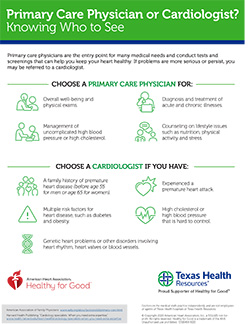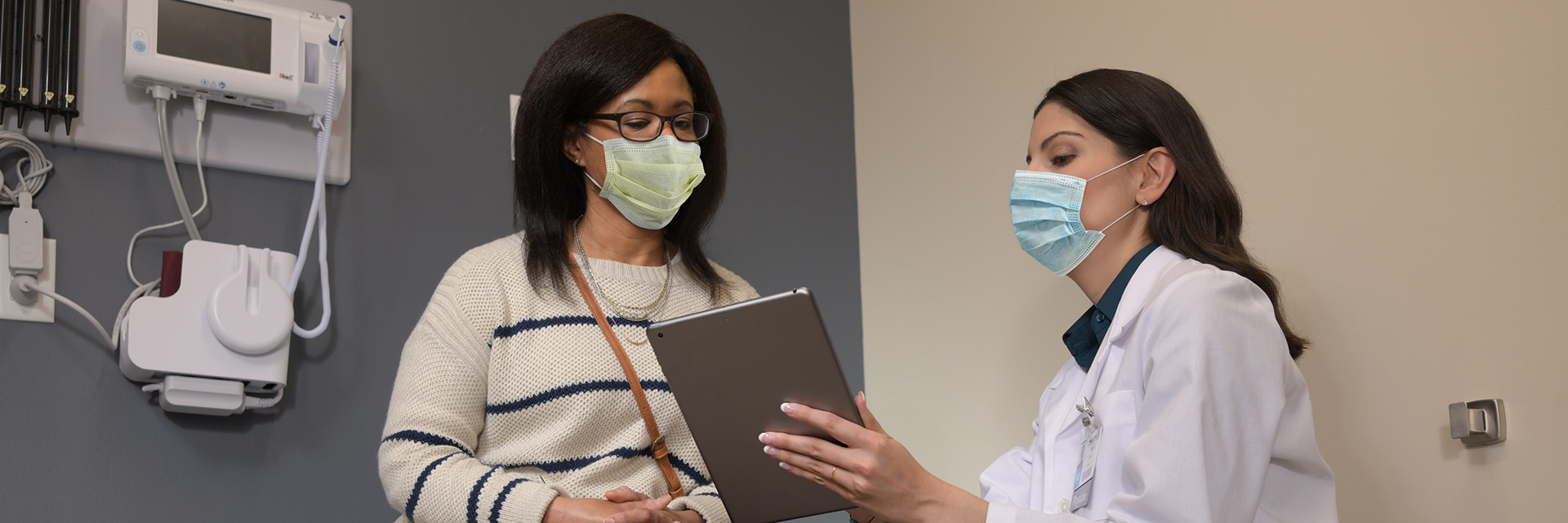Texas Health is proud to join the American Heart Association in the fight against heart disease as the North Texas Go Red for Women® Cause Sponsor. Our involvement with the American Heart Association provides a platform to help educate women on heart health awareness.

Caring for your heart often starts with a visit to your primary care doctor before major symptoms arise.
“You can think of a primary care physician as a jack-of-all-trades doctor,” says Dr. David Ko, a family medicine specialist at Texas Health Family Care, a Texas Health Physicians Group practice in the Colony. “They’re often a good entry point into determining what you need.”
These physicians oversee multiple areas of health care and take a broad view of their patients’ overall well-being.
“Seeing a primary care doctor should not be scary,” Ko says. “It should feel like seeing a good friend who can answer your questions and make you feel comfortable.”
During a typical appointment, vital signs such as heart rate and blood pressure are taken. These numbers, along with a physical exam and blood tests, are valuable in diagnosing and treating many health issues, especially when it comes to your heart. These numbers allow doctors to see changes over time and catch signs of problems early.
“It’s important to have a baseline so, if any other issues come up in the future, we have more pieces of the puzzle to help us determine a treatment plan,” Ko says.
An established relationship with a primary care physician is helpful when dealing with heart issues because many people may lack symptoms early on, he says. Or heart issues may be present in unexpected ways that primary care doctors are trained to look for.
In fact, regular screenings and managing risk factors may lower the risk of cardiovascular disease, according to the American Heart Association. Some of these routine health checks that a primary care physician provides include:
- Calculating body mass index (BMI).
- Monitoring blood pressure, cholesterol and blood glucose.
- Checking on lifestyle habits such as diet, physical activity and smoking.
Ko says one of the most important tools for doctors is simply getting to know their patients. This can uncover insights about who they are as a person and what’s important to them.
“There are a million ways to treat high blood pressure,” he says. “But the right way is different for each patient.”
“When you get to know your patients and ask them how they’re feeling, you can learn a lot about their daily habits, and that can determine a lot about their health.”
Addressing health issues early with a primary care doctor can show benefits later, Ko says. And, even if patients are hesitant to meet a doctor, most are glad they did.
“I have so many new patients who don’t know what to expect, and afterward they’ll say, ‘That wasn’t that bad.’ They say how relieved they are after they visit with me,” he says. “They say they’re more confident and happy to have a plan to face their issues.”
This relief is more accessible these days with doctors offering telehealth visits.
“There are some things we can’t do with telehealth, but there’s a lot we can do,” he says, adding that virtual visits and email communication are convenient ways for you to stay in contact with your doctors should the need arise.
Despite all the things a primary care physician can provide, if symptoms aren’t improving, a referral to a cardiologist may be needed. Some reasons to visit a cardiologist or other specialist include:
- A family history of premature heart disease (before age 55 for men or age 65 for women).
- Experiencing a premature heart attack.
- Multiple risk factors for heart disease, such as diabetes and obesity.
- High cholesterol or high blood pressure that is hard to control.
- Genetic heart disorders.
- Other medical problems that may benefit from a team of experts.
Ko says he can empathize with those who may be apprehensive if they get referred to a specialist. Even he has experienced stress when needing to visit one. However, he realized his nervousness was replaced with relief because the specialist answered his questions and had a step-by-step plan.
“I felt so much better afterward because I was being taken care of,” he says. “I realized that’s how I want all of my encounters to go with my patients.”
For more information or to schedule an appointment with a primary care physician, visit TexasHealthFamilyCare.com. Or to find a heart and vascular specialist, visit TexasHealth.org/Heart.
Texas Health Physicians Group providers are employed by Texas Health Physicians Group and are not employees or agents of Texas Health Resources hospitals.
Doctors on the medical staffs practice independently.

